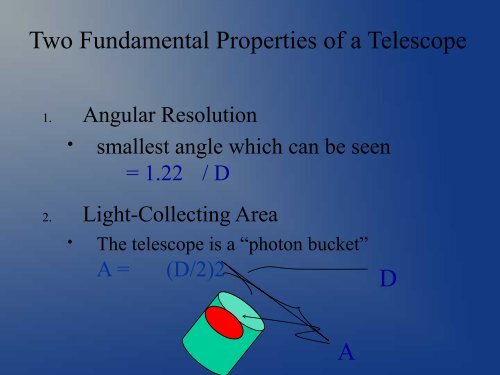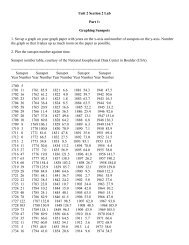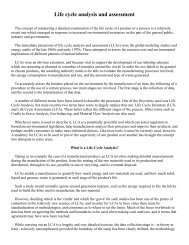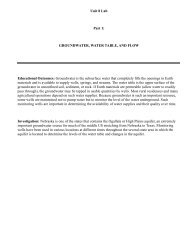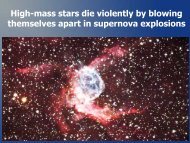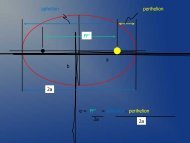Light / Telescopes - Ann Arbor Earth Science
Light / Telescopes - Ann Arbor Earth Science
Light / Telescopes - Ann Arbor Earth Science
You also want an ePaper? Increase the reach of your titles
YUMPU automatically turns print PDFs into web optimized ePapers that Google loves.
Two Fundamental Properties of a Telescope<br />
1. Angular Resolution<br />
• smallest angle which can be seen<br />
= 1.22 / D<br />
2. <strong>Light</strong>-Collecting Area<br />
• The telescope is a “photon bucket”<br />
A = (D/2)2<br />
D<br />
A
Parts of the Human Eye<br />
•<br />
pupil – allows light to<br />
enter the eye<br />
•<br />
lens – focuses light to<br />
create an image<br />
•<br />
retina – detects the<br />
light and generates<br />
signals which are sent<br />
to the brain<br />
A camera works in the same way where the shutter acts<br />
like the pupil and the film or CCD acts like the retina!
Lenses bend <strong>Light</strong><br />
Focus – to bend all light waves coming from the same<br />
direction to a single point<br />
<strong>Light</strong> rays which come from different directions converge<br />
at different points to form an image.
Telescope Types<br />
•<br />
Refractor<br />
– focuses light using lenses<br />
•<br />
Reflector<br />
– focuses light using mirrors<br />
– used exclusively in professional<br />
astronomy today
A refracting<br />
telescope<br />
uses a lens<br />
to<br />
concentrate<br />
incoming<br />
light<br />
Similar to a<br />
magnifying glass
Refracting telescopes have<br />
drawbacks<br />
•<br />
Spherical aberration
Too<br />
spherical
Refracting telescopes have<br />
drawbacks<br />
•<br />
Spherical aberration<br />
•<br />
Chromatic aberration
Special achromatic compound lenses and lens<br />
coatings can often fix this aberration
Refracting telescopes have<br />
drawbacks<br />
•<br />
Spherical aberration<br />
•<br />
Chromatic aberration<br />
•<br />
Sagging due to<br />
gravity distorting<br />
the lens<br />
•<br />
Unwanted<br />
refractions<br />
•<br />
opaque to certain<br />
wavelengths of<br />
light
Refractor<br />
Yerkes 40-inch telescope; largest refractor in the world
Reflector<br />
Gemini 8-m Telescope, Mauna Kea, Hawaii
Reflectors<br />
MMT – Mt. Hopkins, AZ<br />
SUBARU – Mauna Kea, HI
Reflecting telescopes use<br />
mirrors to concentrate incoming<br />
starlight
Newtonian Focus<br />
Prime Focus<br />
Cassegrain focus<br />
coude’ focus
Astronomer’s face two major<br />
obstacles in observing the<br />
skies<br />
•<br />
<strong>Light</strong> Pollution from Cities
Tucson, Arizona in 1959 and<br />
1980
Astronomer’s face two major<br />
obstacles in observing the<br />
skies<br />
•<br />
<strong>Light</strong> Pollution from Cities<br />
•<br />
Effects of Twinkling from <strong>Earth</strong>’s<br />
atmosphere
Rapid changes in the density<br />
of <strong>Earth</strong>’s atmosphere cause<br />
passing starlight to quickly<br />
change direction, making stars<br />
appear to twinkle.
Irregularities in the<br />
atmosphere’s density cause<br />
the light to not arrive at the<br />
telescope as plane parrallel<br />
waves.<br />
Atmosphere<br />
Lens
Haleakalä Observatory,<br />
Maui<br />
(Faulkes Telescope North)
Advanced technology is spawning<br />
a new generation of equipment<br />
to view the universe<br />
•<br />
CCDs (charge-coupled devices)<br />
•<br />
Large telescopes on remote mountain<br />
tops<br />
– Maunakea<br />
– Cerro Pachon in Chile<br />
•<br />
Orbiting space observatories<br />
•<br />
Adaptive Optics to counteract the<br />
blurring of <strong>Earth</strong>’s atmosphere
Adaptive Optics (AO)<br />
•<br />
It is possible to “de-twinkle” a star.<br />
•<br />
The wavefronts of a star’s light rays are deformed by the<br />
atmosphere.<br />
•<br />
By monitoring the distortions of the light from a nearby<br />
bright star (or a laser):<br />
– a computer can deform the secondary mirror in the opposite way.<br />
– the wavefronts, when reflected, are restored to their original state.<br />
•<br />
Angular resolution<br />
improves.<br />
•<br />
These two stars are<br />
separated by 0.38<br />
•<br />
Without AO, we see only<br />
one star.<br />
AO mirror off<br />
AO mirror on
A.O. Movie…<br />
ao-animation.mov
Instruments in the Focal Plane<br />
How do astronomers use the light collected by a telescope?<br />
1. Imaging<br />
– use a camera to take pictures (images)<br />
– Photometry measure total amount of light<br />
from an object<br />
2. Spectroscopy<br />
– use a spectrograph to separate the light into its<br />
different wavelengths (colors)
•<br />
Filters are placed<br />
in front of a camera<br />
to allow only<br />
certain colors to be<br />
imaged<br />
•<br />
Single color images<br />
are superimposed<br />
to form true color<br />
images.<br />
Imaging
A little color theory:
So why do TV’s use<br />
RGB?<br />
Shouldn’t they use<br />
RYB?
Spectroscopy<br />
•<br />
The spectrograph<br />
reflects light off a<br />
grating: a finely ruled,<br />
smooth surface.<br />
•<br />
<strong>Light</strong> interferes with<br />
itself and disperses into<br />
colors.<br />
•<br />
This spectrum is<br />
recorded by a CCD<br />
detector.
Blocking the Aperture
•<br />
Based on the idea of<br />
filling the aperture of<br />
a camera:<br />
Interferometry
kbk
•<br />
Based on the idea of<br />
filling the aperture of<br />
a camera:<br />
Interferometry
Green Bank Interferometer<br />
© 2004 Pearson<br />
Education Inc., publishing
The Very Large Array (VLA)
Traffic Jam, VLA Style
VLA Synthesized Aperture<br />
•<br />
Synthesized<br />
aperture in a<br />
few minutes,<br />
as “seen” by<br />
the radio<br />
source<br />
•<br />
Composed<br />
of 351 pairs<br />
of antennas
Synthesized Aperture—1 hour<br />
•<br />
Synthesized<br />
aperture after<br />
1 hr of <strong>Earth</strong><br />
rotation<br />
•<br />
Each pair<br />
“fills in” more<br />
of the<br />
aperture
Synthesized Aperture—10<br />
•<br />
Synthesized<br />
aperture<br />
after 10 hrs<br />
of <strong>Earth</strong><br />
rotation<br />
•<br />
Aperture is<br />
“filled in”<br />
•<br />
Very high<br />
fidelity<br />
imaging<br />
hours
Radio Galaxy Cygnus A: Pre-VLA
Cygnus A Imaged by the VLA


